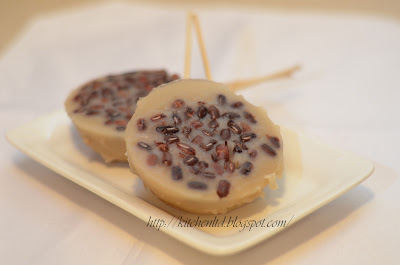 |
| Trio of snowskin mooncakes |
Finally, after two days of experiments, I succeeded in making my favourite mid-Autumn festival treat - Snowskin mooncakes. I have not had a good snowskin mooncakes since I moved away from Singapore. Seven long years... I really missed them.
On impulse, I bought a mini mooncake mould at a local Chinese hardware store and started scouring for a simple snowskin mooncakes recipe. After reviewing several websites, I decided to try
Christine's and
Aunty Yochana's recipes. Both different methods and different flour mixes.
 |
| Soft tender skin with yummy lotus paste |
Armed with a list of ingredients, I headed out to the local Asian supermarket. I was happily checking off my list until my hunt for ready-made lotus paste stopped me in my tracks. I checked out canned food, baking goods, even frozen food but no sight of lotus paste.
Finally, I managed to find a "knowledgeable" store assistant who kindly informed that there is no ready-made lotus paste and I had to make my own! "GASP" - I had intended for a simple mooncake project... I quickly took out my smart phone and google the recipe for lotus paste. This is turning out to be a "massive" project for me.
 |
| Green tea, Panda and White Lotus |
Two days, countless of YouTube videos and recipe reviews later, I am proud to present my mini snowskin mooncakes which stayed soft and tender even after two days in the fridge. I am not sure if it's still soft after that because they were all gone! =)
 |
| White snowskin mooncake, Green tea snowskin mooncake, Panda snowskin mooncake |
Recipe
(Makes 8 ~ 10 white mini snowskin mooncakes with single yolk)
45g Fried glutinous rice flour
5g Wheat flour
50g Icing sugar / Powdered sugar
15g shortening
1 1/2 Tbsp fresh milk
80g room temperature water
200g ready made lotus paste
5 Salted egg yolks (cut into half) (Optional)
100g Fried glutinous rice flour (for dusting)
1. Mix flour and sugar together.
2. Rub-in shortening.
3. Add in milk and water. Mix until dough forms.
4. Knead for 5 minutes or until a smooth dough develop.
5. Wrap dough in cling wrap and covered with a damp cloth.
6. Leave in fridge for at least 3 hours.
7. Divide lotus paste into 10 portions - 20g each.
8. Take a portion of the lotus paste and wrapped around the halved salted egg yolks. Repeat until all lotus paste and yolks are used.
9. Covered work surface with cling wrap and dust with fried glutinous flour.
10. Place dough onto work surface and dust dough with fried glutinous flour.
11. Dust your hands with fried glutinous flour. Divide dough into 10 portion - 20g each.
12. Dust a rolling pin and mooncake mould with fried glutinous flour.
13. Using rolling pin, flatten one portion of dough into 1/4 inch thick.
14. Wrap one portion of the lotus paste with the dough. Cover the paste by pulling the dough to the bottom. When all ends of the dough meet, twist and close. Dust again with fried glutinous flour.
15. Repeat until all paste are wrapped in dough.
16. Place a dough into mould. Press lightly. Turn the mould upside down and knock mould against table until dough dislodge. Repeat until all dough are used.
17. Place mooncakes into a plate or box. Cover with wax paper or parchment paper.
18. Chill in fridge before serving.
Note -
3A. For pandan snowskin, add a drop of pandan paste into milk before
incorporating into the flour mix. Stir until all pandan paste is
combined with milk. Add milk to flour mix and continue with step 3.
3B. For green tea snowskin,
heat milk with 1/4 tsp of sugar in microwave for 15 seconds or until
hot. Stir in 1/8 tsp of green tea powder until smooth. If lumps form,
sift mixture. Add milk to flour mix and continue with step 3.
*****************************************************************************************************************
Tips & Tricks
1. If possible, leave dough in fridge overnight before making the mooncakes. I noticed that the dough is less sticky and does not break easily after it had been refrigerated. A freshly made dough tends to break easily when wrapping around the lotus paste. This is important for a smooth skin.
2. The dough sticks to everything. Remember to dust your hands and the mould when making the mooncakes. I rolled the dough in a plate of fried glutinous flour before putting into the mould.
3. Gauge the portion required for your dough by placing lightly a ball of lotus paste (without the egg yolk) which covers 3/4 of the hole. Then weigh this portion of the lotus paste and weigh equal portion of the dough. Do not press the paste into the mould. It is very difficult to clean.
4. If you omit the egg yolk, then the lotus paste ball should cover 80% of the hole. The weight of dough should be 3/4 of the paste.
Example - 20g lotus paste required to cover 80% of hole. Dough required is 15g.
5. If too much flour is coating your mooncake after removing from mould, gently throw them back and fro between your hands to remove the excess flour. Alternatively, you can use a soft brush to dust away the excess flour. I just used my hands.
6. Fried glutinous flour is more expensive than normal glutinous flour. So for coating and dusting purposes, I steamed normal glutinous flour under high heat for 25 minutes to cook the flour. Cover the normal glutinous flour with a paper towel and cling wrap your plate or bowl when steaming to prevent water from entering the flour. After steaming, sift the steamed flour and it's ready for use - ONLY for coating and dusting. You can omit this step and use fried glutinous flour for coating.
7. If fresh dough breaks easily, it's too dry. Add some water. If you find it too wet, add some fried glutinous flour.
8. Will update again for - Lotus Paste recipe and
Homemade Salted Eggs recipe.
9. Adapted recipe from
Aunty Yochana's. I find that the texture of the dough, from those recipes which require steaming, is harder than those which uses fried glutinous flour.
*****************************************************************************************************************
My Asian Kitchen
 |
| Fried Glutinous Flour |
Fried glutinous flour is a type of flour that has already been cooked. To avoid steaming the batter for the dough, you have to use this flour. You can find this flour in most major Asian supermarket. I was unable to find this in smaller Asian supermarkets. This will be found in the Asian flour section. I got this for US$2.50.
 |
| Wheat Starch |
This is uncooked wheat flour. A small amount of this is added to the dough to make it less sticky. You can find this in most Asian supermarkets (even the smaller ones) and in the Asian flour section. You can steam this, instead of glutinous flour, for coating - See Tips & Tricks #6. I got this for US$1.50.
 |
| Glutinous Rice Flour |
This is raw glutinous rice flour. If you are using a recipe which requires steaming the batter or dough, you will use this. You can find this in most Asian supermarkets and in the Asian flour section. I got this for US$1.
Please refer to my
Chwee Kuay recipe for a picture of Rice Flour.
































